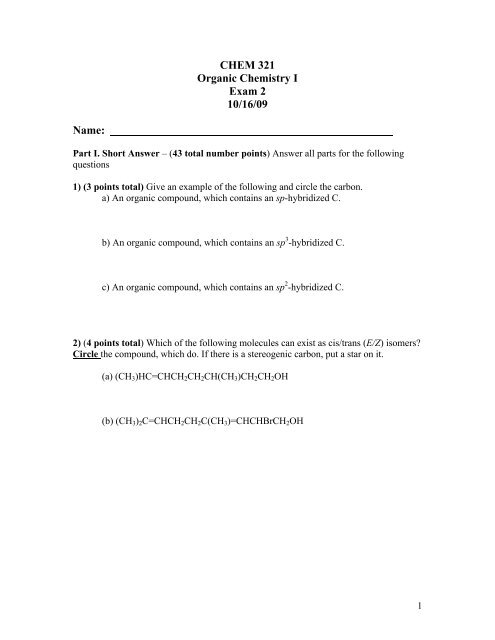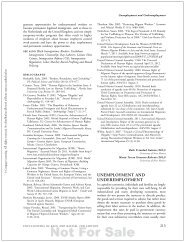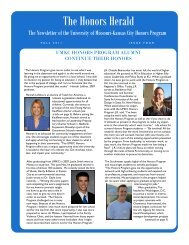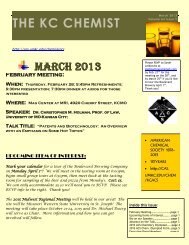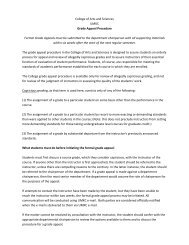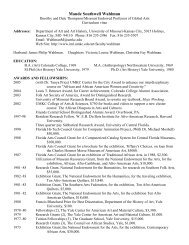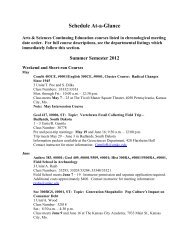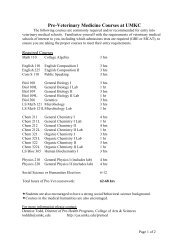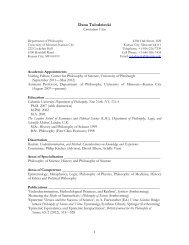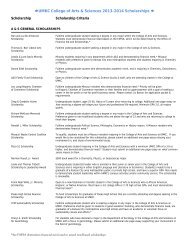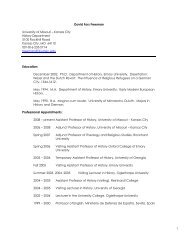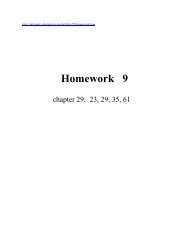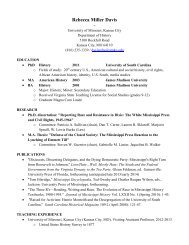CHEM 321 Organic Chemistry I Exam 2 10/16/09 Name:
CHEM 321 Organic Chemistry I Exam 2 10/16/09 Name:
CHEM 321 Organic Chemistry I Exam 2 10/16/09 Name:
Create successful ePaper yourself
Turn your PDF publications into a flip-book with our unique Google optimized e-Paper software.
<strong>Name</strong>:<br />
<strong>CHEM</strong> <strong>321</strong><br />
<strong>Organic</strong> <strong>Chemistry</strong> I<br />
<strong>Exam</strong> 2<br />
<strong>10</strong>/<strong>16</strong>/<strong>09</strong><br />
Part I. Short Answer – (43 total number points) Answer all parts for the following<br />
questions<br />
1) (3 points total) Give an example of the following and circle the carbon.<br />
a) An organic compound, which contains an sp-hybridized C.<br />
b) An organic compound, which contains an sp 3 -hybridized C.<br />
c) An organic compound, which contains an sp 2 -hybridized C.<br />
2) (4 points total) Which of the following molecules can exist as cis/trans (E/Z) isomers?<br />
Circle the compound, which do. If there is a stereogenic carbon, put a star on it.<br />
(a) (CH3)HC=CHCH2CH2CH(CH3)CH2CH2OH<br />
(b) (CH3)2C=CHCH2CH2C(CH3)=CHCHBrCH2OH<br />
1
3) (7 points) Provide the following:<br />
a) Give an example of an alcohol and name it.<br />
b) <strong>Name</strong> the following bicyclic compound:<br />
Cl<br />
c) Give an example of a diol:<br />
d) Give an example of an ether and name it:<br />
4) (2 points) Circle the group, which is most acidic in the following compounds<br />
HO<br />
F Cl<br />
OH<br />
5) (1 point each/ total 3 points) What are the conjugate acids for the compounds below?<br />
a) H2O b) NH3 c) CH3OH<br />
6) (1 point each/ total 3 points) What are the conjugate bases for the compounds below?<br />
a) H2O b) NH3 c) CH3OH<br />
OH<br />
SH<br />
2
7) (1 point each/21 total points) For each statement, circle the most appropriate<br />
word to make the statement correct.<br />
a) The hydration reaction is the addition of H2O across the double bond in (acid, base, or<br />
spaghetti)-catalyzed conditions.<br />
b) The formula used to calculate the theoretical amount of stereoisomers is (2 n , nx + b, or<br />
a 2 + n 2 ) where n is the number of chiral centers.<br />
c) Pentahelicene is (achiral, chiral or meso) compound.<br />
d) 2,3-Butadiene is (achiral, chiral or meso) compound.<br />
e) Biphenyl is (achiral, chiral or meso) compound.<br />
f) The torsional strain in planar cyclohexane is (higher, lower, or the same) than planar<br />
cyclopentane.<br />
g) The angle strain of cyclopropane is (higher, lower, or the same) than planar<br />
cyclobutane.<br />
h) The heat of formation in the standard states of cyclopentane is (more than, less than or<br />
the same) than that of cyclohexane.<br />
i) The heat of combustion in the standard states of cyclohexane is (more than, less than or<br />
the same) than that of cyclopentane.<br />
j) Cis 1,3-dimethylcyclohexane is (achiral, chiral or meso) compound.<br />
3
k) One conformational stereoisomer of (S,S) trans-1,2-dichlorocyclohexane converts to<br />
(RR; RS; SR; or SS) trans-1,2-dichlorocyclohexane via a chair flip.<br />
l) The relationship between the chair interconversion of 1,1-dimethylcyclohexane is that<br />
they are (conformational enantiomers, conformational diastereomers, or identical).<br />
m) The relationship between the chair interconversion of cis-1,2-dimethylcyclohexane is<br />
that they are (conformational enantiomers, conformational diastereomers, or identical).<br />
n) The relationship between the chair interconversion of trans-1,2-dimethylcyclohexane<br />
are that they are (conformational enantiomers, conformational diastereomers, or<br />
identical).<br />
o) The relationship between the chair interconversion of cis-1,3-dimethylcyclohexane are<br />
that they are (conformational enantiomers, conformational diastereomers, or identical).<br />
p) The relationship between the chair interconversion of trans-1,3-dimethylcyclohexane<br />
are that they are (conformational enantiomers, conformational diastereomers, or<br />
identical).<br />
q) The relationship between the chair interconversion of cis-1,4-dimethylcyclohexane are<br />
that they are (conformational enantiomers, conformational diastereomers, or identical).<br />
r) The relationship between the chair interconversion of trans-1-isopropyl-2methylcyclohexane<br />
are that they are (conformational enantiomers, conformational<br />
diastereomers, or identical).<br />
4
s) The relationship between the chair interconversion of trans-1,4-dimethylcyclohexane<br />
are that they are (conformational enantiomers, conformational diastereomers, or<br />
identical).<br />
t) Homework for our course is due by 5 PM of (the same class period, the next class<br />
period, or the next week) after we complete the chapter.<br />
Short Answer (31 points) Answer all parts for the following reactions.<br />
8) (<strong>10</strong> points) Star the chiral (stereogenic centers) in the compound (cortisone) below.<br />
Then, assign chirality (R or S) to each of those centers. Theoretically, how many possible<br />
stereoisomers would there be for the structure below?<br />
O<br />
O<br />
CH 3<br />
H<br />
H<br />
O<br />
CH 3<br />
H<br />
OH<br />
OH<br />
5
9) (21 points) For all of the following reaction, show all of the products (7 points each).<br />
Note the stereochemistry (R/S and * the chiral centers) and major/minor product where<br />
necessary. Also, pick one reaction and show the mechanism for the formation of the<br />
products for the first reaction (7 points). If some part of your reaction is written in<br />
another place, clearly indicate where. Circle all of your products.<br />
b)<br />
a)<br />
1) H-Br<br />
2) Mg, ether<br />
3) D2O H 3O +<br />
H 2O<br />
6
Part III. Essay. (26 points)<br />
<strong>10</strong>) (13 points) Draw all of the possible chair forms and stereoisomers of cis- and trans-<br />
1-bromomethyl-2-chlorocyclohexane. State the relationships between isomers, state the<br />
relationships between their flipped isomers, label R/S if applicable, and specify their<br />
stability.<br />
7
11) (13 points) Draw all of the possible chair forms and stereoisomers of cis- and trans-<br />
1,3-diisopropylcyclohexane. State the relationships between isomers, state the<br />
relationships between their flipped isomers, label R/S if applicable, and specify their<br />
stability.<br />
8


